Senegal: Manatees in the Desert
I worked and traveled around Senegal for almost all of January, but internet access was hard to come by, and even when I got online, I usually only had a few minutes to check emails. So I have a lot of news to catch up on! I arrived in Dakar, the capital of Senegal, on 5 January and spent the first week meeting with collaborators to plan the manatee captures and helping to arrange logistics for the field site at Navel, which is a 10 hour drive across eastern Senegal. There are many groups and agencies involved in manatee issues here: on the government side there are representatives from Senegal national parks, Water and Forestry Dept. and the Fisheries Ministries of Navel and Matam. NGOs involved included CBD-Habitat, Oceanium Dakar, Wetlands International, and of course myself from Wildlife Trust.
On 11 January CBD-Habitat collaborators arrived from Spain and Guinea-Bissau, and the next day we began the drive across the desert to Navel. It took a day and a half to get there, and it was an interesting drive into a land of sand and scrub trees, with many small villages where people eke out a living by herding cattle, goats or sheep, and fishing in the river. The weather in Senegal was a lot colder at this time of year than I expected but the desert was definitely as bone dry as I expected. One word sums up this part of the world: dust. It is everywhere, it gets in everything and the wind never seems to stop. As we drove for hours across the desert landscape, it felt like this was the last place on earth I would ever expect to find a manatee! We arrived in Ourosogui (bigger town near Navel), settled into the hotel and then went out to see the site.

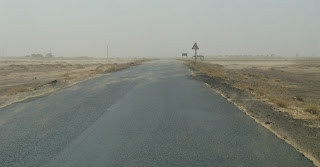 Typical village along the road.
Typical village along the road.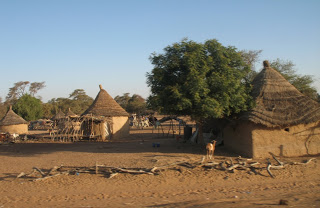 Before I came to Senegal I was told there were at least 15 manatees trapped behind a new dam off the Senegal River. However, I learned after I got here that it is a lot more complicated than that. As the Senegal River floods during the rainy season, it spreads into many small tributaries. People are successively damming these smaller branches to keep the water longer into the dry season and grow crops as the water recedes. It turns out there are manatees trapped in at least three different areas spread out over approximately 35km near the towns of Matam and Kanel. Navel was the most critical location because the water was falling the fastest and would leave the manatees high and dry long before the next rains begin.
Before I came to Senegal I was told there were at least 15 manatees trapped behind a new dam off the Senegal River. However, I learned after I got here that it is a lot more complicated than that. As the Senegal River floods during the rainy season, it spreads into many small tributaries. People are successively damming these smaller branches to keep the water longer into the dry season and grow crops as the water recedes. It turns out there are manatees trapped in at least three different areas spread out over approximately 35km near the towns of Matam and Kanel. Navel was the most critical location because the water was falling the fastest and would leave the manatees high and dry long before the next rains begin.
The channel of water where manatees were trapped at Navel is approximately 600 meters long, ~14m wide and ~1.5m deep. I saw 5 noses in the chocolate milk water the first day when we scouted the area, but no one knew for sure at that time how many were there. A guardian had been hired to watch the manatees day and night, because some people here believe the breath of a manatee can kill a person, so they will try to kill them.

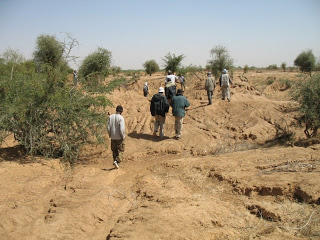
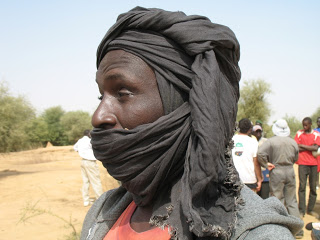 After visiting the site, I trained Victor and Pablo how to assemble the satellite tags which we planned to put on several of the manatees to track their movements. Unfortunately we had some difficulties with the lithium battery packs, so we only ended up with enough batteries for 3 tags, rather than the 5 we brought. But any data we get will be important: not much is known about manatee migration patterns in the Senegal River, their habitat requirements or even how many manatees there are.
After visiting the site, I trained Victor and Pablo how to assemble the satellite tags which we planned to put on several of the manatees to track their movements. Unfortunately we had some difficulties with the lithium battery packs, so we only ended up with enough batteries for 3 tags, rather than the 5 we brought. But any data we get will be important: not much is known about manatee migration patterns in the Senegal River, their habitat requirements or even how many manatees there are.  In the meantime, back at the capture site, workers cleared a path in the hillside so that we could back a trailer attached to a tractor (generously loaned by SAED, the Fisheries Dept.) down the hill to the water’s edge. (photo by P. de Larrinoa, CBD-Habitat)
In the meantime, back at the capture site, workers cleared a path in the hillside so that we could back a trailer attached to a tractor (generously loaned by SAED, the Fisheries Dept.) down the hill to the water’s edge. (photo by P. de Larrinoa, CBD-Habitat)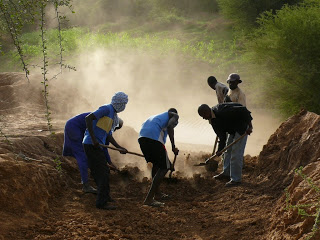 On the morning of 14 January fishermen from Navel and Matam entered the waterway with nets and captured 3 manatees. It was nerve-wracking because the fishermen just sort of “wing it” and not much is coordinated. As the manatees were brought to shore, literally hundreds of people who had assembled along the shoreline descended upon the manatees, most eager to see them, but some wanting to beat them. We had arranged for police officers for protection, but it felt like nothing compared to the huge crowd pressing in. We were only able to accommodate 2 manatees in the trailer, so the fishermen loaded an adult and a sub-adult, and we left the third manatee with several policemen and biologists to watch it while we drove the first two to the release site several kilometers away.
On the morning of 14 January fishermen from Navel and Matam entered the waterway with nets and captured 3 manatees. It was nerve-wracking because the fishermen just sort of “wing it” and not much is coordinated. As the manatees were brought to shore, literally hundreds of people who had assembled along the shoreline descended upon the manatees, most eager to see them, but some wanting to beat them. We had arranged for police officers for protection, but it felt like nothing compared to the huge crowd pressing in. We were only able to accommodate 2 manatees in the trailer, so the fishermen loaded an adult and a sub-adult, and we left the third manatee with several policemen and biologists to watch it while we drove the first two to the release site several kilometers away.
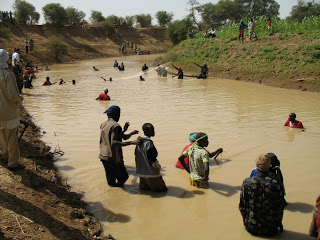 It’s hard to see the manatee in the middle! (photo by C. Schwarz)
It’s hard to see the manatee in the middle! (photo by C. Schwarz)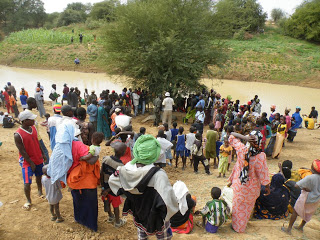 I have to say I have never experienced such chaos during manatee captures ever before. People literally ran up to the trailer, grabbing and trying to fling themselves in, caught up in the hysteria of the crowd. People were lined up along the road the entire 3km route and a convoy of trucks and cars followed behind us, all filled to the brim with people yelling. There was absolutely no restraint by the people so I was glad for the 3 police officers in the trailer with us.
I have to say I have never experienced such chaos during manatee captures ever before. People literally ran up to the trailer, grabbing and trying to fling themselves in, caught up in the hysteria of the crowd. People were lined up along the road the entire 3km route and a convoy of trucks and cars followed behind us, all filled to the brim with people yelling. There was absolutely no restraint by the people so I was glad for the 3 police officers in the trailer with us.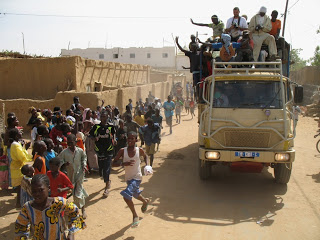 Inside the trailer our work space was very confined due to the 2 manatees, our equipment and about 10 people. We mostly had to work while the trailer was moving, because stopping for any length of time meant the crowds descended on us again. This meant that there was alot of data we just could not collect (some basic measurements, blood draw for baseline health information, etc.). We did what we could (I also needed to train the other biologists since most of them had not worked with manatees before) and we got most measurements, genetic samples and determined the sex on all of the manatees over the two days of captures. I also trained the biologists how to attach the tracking gear.
Inside the trailer our work space was very confined due to the 2 manatees, our equipment and about 10 people. We mostly had to work while the trailer was moving, because stopping for any length of time meant the crowds descended on us again. This meant that there was alot of data we just could not collect (some basic measurements, blood draw for baseline health information, etc.). We did what we could (I also needed to train the other biologists since most of them had not worked with manatees before) and we got most measurements, genetic samples and determined the sex on all of the manatees over the two days of captures. I also trained the biologists how to attach the tracking gear.
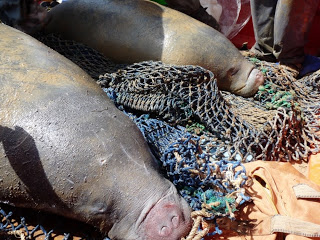 Veterinary student Prisca gets ready to take a genetic sample.
Veterinary student Prisca gets ready to take a genetic sample. Demonstrating belt attachment around the manatee’s tail. The tag is attached to this by a tether. (photo: T. Diagne)
Demonstrating belt attachment around the manatee’s tail. The tag is attached to this by a tether. (photo: T. Diagne)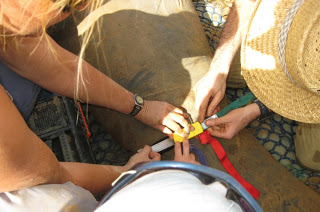 On their way to the release site, the manatees were transported across the new dam that had trapped them in the first place. Thousands more people were waiting at the release site. We released the first 2 manatees (one with a tag) and headed back for the third. Apparently while we were gone, some of the people had panicked that the manatee was going to die before we returned, so they had tried to load it into a pickup truck. There was nothing wrong with the manatee, it had been kept in the shade and water was poured over it to keep it cool. Unlike dolphins, manatees can comfortably stay out of the water on land for several hours as long as they are monitored and kept cool, because their solid rib bones support their internal organs. But the people watching it did not know this, and in the confusion I had not thought to tell them. We loaded it in the trailer and repeated the trip to the release site. This manatee was also a male and we tagged it as well.
On their way to the release site, the manatees were transported across the new dam that had trapped them in the first place. Thousands more people were waiting at the release site. We released the first 2 manatees (one with a tag) and headed back for the third. Apparently while we were gone, some of the people had panicked that the manatee was going to die before we returned, so they had tried to load it into a pickup truck. There was nothing wrong with the manatee, it had been kept in the shade and water was poured over it to keep it cool. Unlike dolphins, manatees can comfortably stay out of the water on land for several hours as long as they are monitored and kept cool, because their solid rib bones support their internal organs. But the people watching it did not know this, and in the confusion I had not thought to tell them. We loaded it in the trailer and repeated the trip to the release site. This manatee was also a male and we tagged it as well.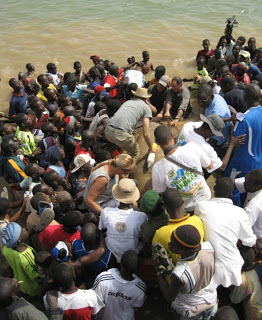
The moment of release!
 After that the fishermen decided they would not continue that day. A meeting was called and the Matam fishermen demanded a lot more money to continue helping with the captures. The thing was, we really didn’t need all the huge numbers of people in the water anyway, and the fishermen didn’t realize that the 15 or so biologists present could just as easily catch the manatees without them. So we called their bluff and the next day it was just the biologists and the Navel fishermen back at the capture site. Fewer people turned up to watch as well. This turned out to be so much better, there was less chaos and a lot better communication between everyone, so the whole day was a lot more relaxed. We caught 2 more manatees (a female and a huge adult male) and tagged the female. After that the creek was searched until we were satisfied all the manatees were out.
After that the fishermen decided they would not continue that day. A meeting was called and the Matam fishermen demanded a lot more money to continue helping with the captures. The thing was, we really didn’t need all the huge numbers of people in the water anyway, and the fishermen didn’t realize that the 15 or so biologists present could just as easily catch the manatees without them. So we called their bluff and the next day it was just the biologists and the Navel fishermen back at the capture site. Fewer people turned up to watch as well. This turned out to be so much better, there was less chaos and a lot better communication between everyone, so the whole day was a lot more relaxed. We caught 2 more manatees (a female and a huge adult male) and tagged the female. After that the creek was searched until we were satisfied all the manatees were out.
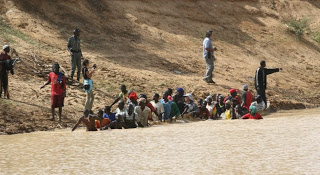

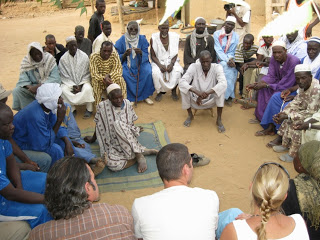 There were several film crews there as well- this is Madame Thiam of Senegal National Parks giving an interview. I also gave an interview but fumbled my French halfway through, the next day it was played on national TV and they didn’t edit when I lapsed into English and then said “Oops!”. So that’s my graceful moment on Senegal TV.
There were several film crews there as well- this is Madame Thiam of Senegal National Parks giving an interview. I also gave an interview but fumbled my French halfway through, the next day it was played on national TV and they didn’t edit when I lapsed into English and then said “Oops!”. So that’s my graceful moment on Senegal TV. Since their release the tagged manatees have been doing some very interesting things. The 2 males made big moves away from the release site, one to the north and one to the south, towards Mali (these sprints are the manatee equivalent of “get me outta here!”). But after several days both stopped and they are likely feeding. There was no natural food at this time of year in the creek where they were trapped, so plants were provided for them, but I’m sure they were very hungry. Luckily none were too thin when we caught them. The female moved slightly to the north but settled down more quickly.
Since their release the tagged manatees have been doing some very interesting things. The 2 males made big moves away from the release site, one to the north and one to the south, towards Mali (these sprints are the manatee equivalent of “get me outta here!”). But after several days both stopped and they are likely feeding. There was no natural food at this time of year in the creek where they were trapped, so plants were provided for them, but I’m sure they were very hungry. Luckily none were too thin when we caught them. The female moved slightly to the north but settled down more quickly.
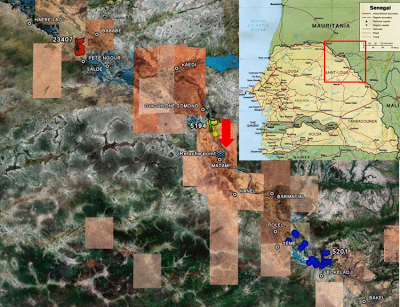 At the end of the operation we all felt it was a big success. Our great team included biologists from 4 countries. Pictured are (back row): Junior (CBD-Habitat, Guinea-Bissau), Prisca (veterinary student, Senegal), Iris (CBD-Habitat, Guinea-Bissau), Pablo (CBD-Habitat, Spain). In front: Luis Mariano (Spain), Tomas (Oceanium Dakar, Senegal), Lucy (Wildlife Trust, USA) and Cristina (CBD-Habitat, Guinea-Bissau). Not pictured are Paco and Victor from Spain, Luis from CBD-Habitat, Guinea-Bissau and Papis from Senegal.
At the end of the operation we all felt it was a big success. Our great team included biologists from 4 countries. Pictured are (back row): Junior (CBD-Habitat, Guinea-Bissau), Prisca (veterinary student, Senegal), Iris (CBD-Habitat, Guinea-Bissau), Pablo (CBD-Habitat, Spain). In front: Luis Mariano (Spain), Tomas (Oceanium Dakar, Senegal), Lucy (Wildlife Trust, USA) and Cristina (CBD-Habitat, Guinea-Bissau). Not pictured are Paco and Victor from Spain, Luis from CBD-Habitat, Guinea-Bissau and Papis from Senegal. 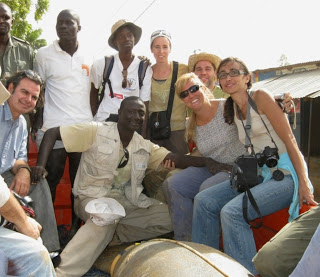

Wow. Am so glad to have finally caught up on your blog! What a great description. So much of it sounds and feels very familiar. That first capture day must have been a dooo-sey! Nice going, sibling! 🙂 This is truly wonderful work that you’re doing. Looking forward to many more photos and stories when you get back. xo